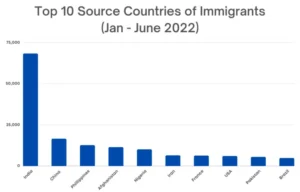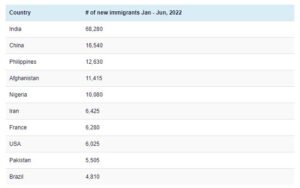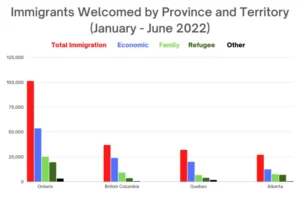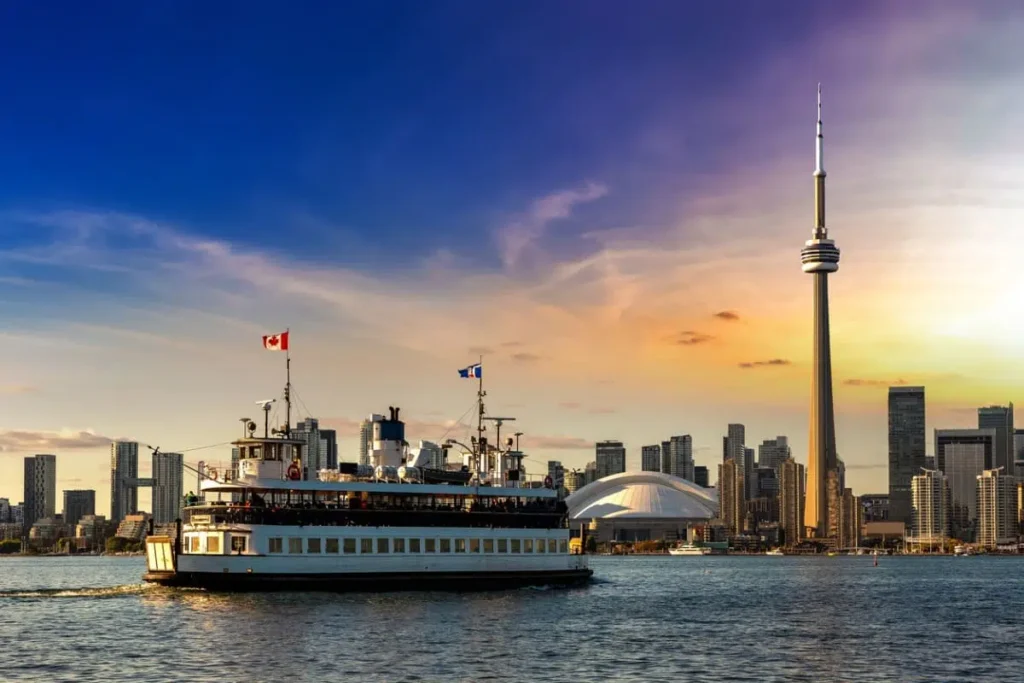Analysis: IRCC data suggest Canada could meet or exceed this year’s expectations. Most immigrants to Canada so far have come from India. Ontario continues to be the top province for new immigrants.
As of August 22, Canada has welcomed about 300,000 new permanent residents.
Immigration Minister Sean Fraser boasted last week that Canada has hit the 300,000 mark earlier this year than any other year. Since Confederation in 1867, Canada has welcomed more than 300,000 immigrants in an entire year only six times: in the years of 1911 to 1913 and then in 2018, 2019, and 2021.
After pandemic-related travel restrictions caused a slump of newcomers in 2020, Immigration, Refugees and Citizenship Canada (IRCC) ramped up immigration in 2021, ending off the year with a record-breaking 405,330 newcomers. Even so, IRCC did not surpass the 300,000 mark until the fourth quarter that year.
Publicly available data on IRCC’s open data portal has so far reported the numbers of new immigrants up until June 2022. The results for July and August will be released in the upcoming months.
By the end of June, about 231,620 newcomers had immigrated to Canada. The difference between the figures from the end of June to August suggests Canada has welcomed some 68,000 permanent residents over the course of two months.
If this rate keeps up for the remaining four months of the year, Canada could meet or even exceed its target of 431,000 new immigrants in 2022. Should the immigration department reach this target, it would blow past the previous record set in 2021.
The available data show us which countries immigrants are emigrating from and the Canadian provinces and territories where they are landing.
IRCC rounds data to the nearest five as part of an effort to protect individual privacy, and prevent individuals from being identified. As a result, the sum of the data may not always equal the total.
Here are some key insights into Canadian immigration during the first half of 2022.
Top 10 source countries
India remains the top source country of new immigrants by a large margin. In the first half of the year, 68,280 Indians have received Canadian permanent residence, representing 29% of all immigrants to Canada. Indian citizens have consistently been the top source country of new immigrants to Canada since 2017.
There was a significant increase in permanent residents from Afghanistan following the Taliban take over. In 2021, Afghanistan was the ninth most popular source country of newcomers overall, after a surge of Afghan immigration to Canada followed in the second half of 2021 when the federal government promised to resettle 40,000 refugees fleeing the county. So far this year, Afghanistan is coming in at number four. As of August 31, 2022, about 18,075 refugees have arrived in Canada under new permanent residency programs for Afghans.

Provincial immigration
Ontario has by far been the most popular landing province of immigrants. A total of 101,155 newcomers have immigrated to Ontario in the first six months of the year, nearly triple that of the second place contender, British Columbia. The province of BC is now home to 36,700 new permanent residents as of the end of June.
Quebec welcomed the third most immigrants overall, starting the first half of the year with 31,880. Alberta came in fourth with 26,920 newcomers

Ontario also welcomed the most in all of Canada’s immigration classes: economic, family, refugee, and other. BC welcomed the second most economic- and family-class immigrants, and came in third under the other category. Alberta accepted the second highest number of refugees and the third most family-class immigrants. Quebec had the third most economic- and refugee-class immigrants, and the second most welcomed under the other category.


